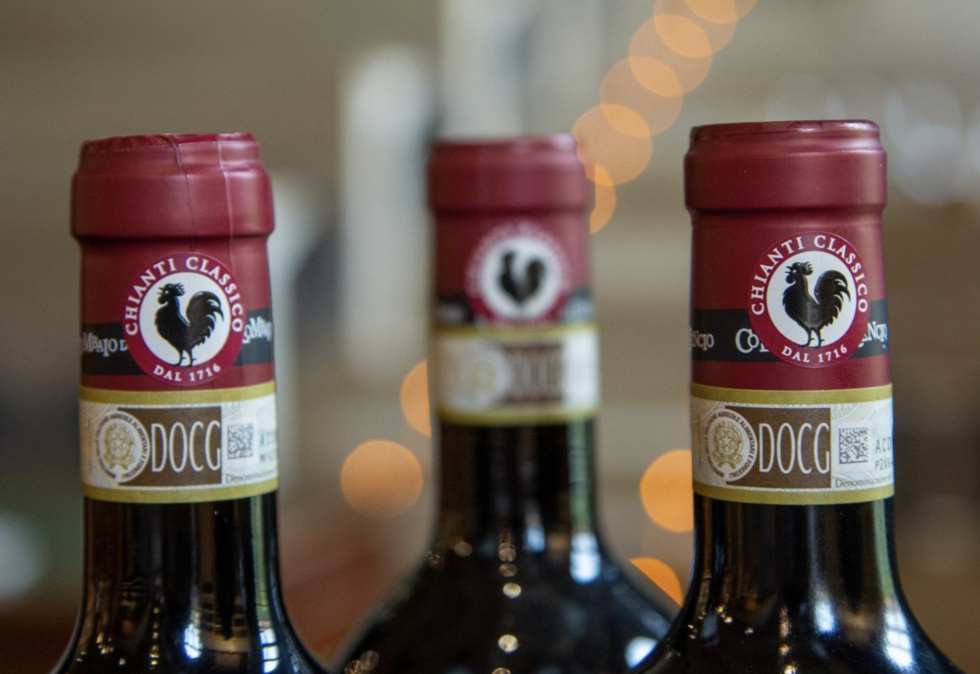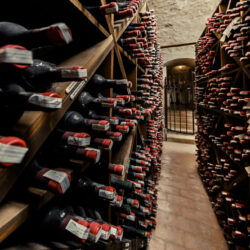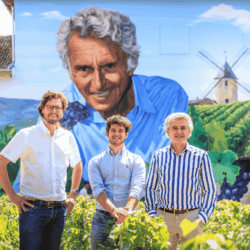The Consorzio Vino Chianti Classico is the oldest consortium of winegrowers in Italy, with its signature black rooster emblem differentiating its members’ bottles from any other Chianti or Sangiovese-based wine since 1924. But the roots of the organisation go back even further, to 1716 when Cosimo III de’ Medici codified the territory and its wines for legal protection.
Tuscan native Daniele Arcangeli, head sommelier at The River Restaurant by Gordon Ramsay in London, vividly remembers pressing grapes with his bare feet during the harvest when he was just 10 years old, and also recalls his grandfather adding a splash of wine to his water. Here he shares his knowledge on Italy’s renowned wine region, which covers approximately 7,000 hectares between Florence and Siena.
“Chianti Classico is one of the leading Italian wine appellations, a place where you can breathe the history, the culture and the traditions of Tuscany. Unlike Chianti that covers a bigger area of production in several Tuscan provinces, the delimited area of Chianti Classico, the historic area, is the beating heart of Tuscan viticulture.
Situated between Florence and Siena provinces, it encompasses 11 sub-regions or villages with different geologic and climatic features, different altitudes and expositions that give wines with different character. Chianti Classico area is a breathtaking landscape of endless vineyards of dramatic beauty.
Centuries of provenance
The history of Chianti Classico has ancient roots, with the first mention of the word Chianti being recorded in 1398 referring to a purchase by Ser Lapo Mazzei of six ‘barili’ (casks) of white wine from Chianti.
Chianti – the suffix ‘Classico’ was added in 1932 – has an important historical place in the world of wine, becoming the first wine making area to be delimited and defined by law. In 1716, Grand Duke Cosimo III, with a specific edict, delineated the borders of the Chianti wine area.
Tuscany was formerly known as Etruria, and it was the ancient population of Etruscans who lived there that first developed viticulture in the region. There were no vineyards as we understand the term today, instead, the vines were mixed with other crops, alternated with fields of cereals, olive trees and fruit trees. The vine maritata has remained in the Italian wine culture until this day in all those territories where in antiquity the Etruscan civilisation had arrived.
As stated in a document in 1773, Chianti was made predominantly with Canaiolo Nero to which was added a small quantity of Sangiovese, Mammolo and Marzemino from mixed field blends. It also mentioned the use of white grapes, including Trebbiano and San Colombano.
In 1872 Sangiovese took over Canaiolo thanks to Baron Bettino Ricasoli’s blend composed of 70% Sangiovese combined 30% of Canaiuolo and Malvasia.
Recent history and the future
By 1924 Italo de Lucchi, Mayor of Greve put together winegrowers in Radda to form a consortium to protect the territory of Chianti, its wine growers and its wines. The consortium banned white grape varieties from the 2005 vintage onwards.
Chianti Classico played a key role also in the creation of the sought-after Super Tuscans wines. Tignanello, produced by Antinori in Greve in Chianti, was the first Sangiovese to be aged in barriques, the first contemporary red wine blended with untraditional grape varieties and one of the first red wines in the Chianti Classico region that didn’t use white grapes. It was released for the first time in 1970 as Chianti Classico Riserva Vigneto Tignanello, and then became Tignanello IGT in 1971.
As we look to the future, climate change has already raised the average temperature in recent decades affecting the growing season and producing wines with more fruit concentration, alcohol level, body and texture, so we won’t find anymore wines at 12-12.5% abv.
Around the wine regions
Wines from Chianti Classico have a distinctive character depending on the area or sub-region they come from, the type of soil, elevation and exposure, as well as the winemaking style, which imparts a certain personality to the wine itself.
Broadly speaking, elevation and strong diurnal shift affect acidity and aroma, climate and exposure affect maturation as type of soils there are lots of variants to take into consideration.
 For instance, Chianti Classico from Lamole are ethereal wines with a pale brilliant ruby colour, characterised by a great finesse, streamlined lean body, in proportion more floral than fruity, crunchy red fruits of cherry and cranberry, floral notes of violet, iris and lavender, and sharp, mouthwatering acidity and a slender tannin.
For instance, Chianti Classico from Lamole are ethereal wines with a pale brilliant ruby colour, characterised by a great finesse, streamlined lean body, in proportion more floral than fruity, crunchy red fruits of cherry and cranberry, floral notes of violet, iris and lavender, and sharp, mouthwatering acidity and a slender tannin.
Lamole, a sub-region that once belonged to Greve in Chianti but is now an independent Unità Geografiche Aggiuntive (UGA), is a cool climate sub-region that has a strong diurnal shift, high elevation terraced vineyards, old bush trained vines and a sandy soil called Arenaria, it is the lightest expression of Chianti Classico.
On the other hand, if you are looking for something more extractive and powerful, wines from the famous sun-kissed amphitheatre Conca d’Oro, the golden basin in Panzano in Chianti, offer deep, concentrated, muscular wines with a luscious fruit, higher alcohol levels, and bold and chewy tannin.
Main soils are Galestro, a crumbly schistose clay soil that gives robust wines, powerful concentration and tannic structure, and Pietraforte, a limestone with high carbonate of calcium that we find mainly in the cooler northern area of Panzano. it is also a stone used to build the most important Florentine palaces such as Palazzo Vecchio, Palazzo Medici and Palazzo Pitti.
Castelnuovo Berardenga is also sun-blessed; here we have more light and less rain, it is the southernmost and one of the warmest communes with south-facing vineyards rich with galestro and tufa soil. Here, the wines are the ones that are closest to Montalcino style, with more alcohol level, structure, extraction, dark fruits character, fruit ripeness, tobacco, mediterranean herbs of rosemary, bay leaf, thyme, juniper balsamic notes of resin and solid tannins.
Wines from Radda in Chianti are more powerful than those from Lamole; they are a bit angular and austere in their youth but develop an amazing finesse and elegance with bottle ageing, becoming the sleekest and more refined wines of Chianti Classico, with notes of iron, graphite, dry leaves, charcoal, blood orange and Chinotto bitter orange.
Montefioralle is another new UGA that belonged to Greve, where the wines produced are savoury and sapid, and are fuller than Lamole due to the presence of clay.
Understanding Chianti Classico on wine lists
Drinking Chianti Classico is pure pleasure; the category annata is the most approachable example due to its high drinkability, elegance and freshness. Commercially speaking, it’s not considered only a winery’s calling card, but also the most important wine being produced in large quantities, it’s not just the wine that pays the bills but also represents the style of winery and character of the place where it comes from.
Having a Chianti Classico on the wine list is important for every restaurant, essential in a classic refined Italian restaurant, and a must-have in a fine dining restaurant.
A significant new step is underway in the form of a project to subdivide the Chianti Classico production zones into smaller and more homogenous areas, the names of which will be shown on the labels. Personally speaking, the big change will be when we will be able to read on Chianti Classico front labels the name of the village or the sub-region, such as Chianti Classico-Radda, Chianti Classico-Lamole or Chianti Classico-Panzano, for instance.
Enjoy Chianti Classico with food
Not everyone knows that Chianti Classico is a polyhedric wine that matches lots of different types of food, from classic Tuscan antipasti, cold cuts, cured cheese, and Pappa al Pomodoro (tomatoes bread soup), Ribollita (a slow-cooked vegetable soup featuring savoy cabbage, kale and cannellini beans), the classic Fiorentina, Chianina beef T-Bone steak served with porcini mushrooms and Parmigiano Reggiano.
Red wine with fish? Why not, try a beautiful Chianti Classico Annata from Lamole with a Cacciucco alla Livornese, a slow-cooked fish soup made of 14 different species of local fish and tomato).
Choosing favourites
My favourite Chianti Classicos come from cool climate areas of the appellation such like Lamole, Monti in Gaiole, North-western area of Castellina, Montefioralle, Northern area of Panzano and Radda of Course, juicy and balanced ones, rather than muscular, chewy and powerful examples.
My favourite producers:
Le Cinciole and Castello dei Rampolla in Panzano in Chianti
I Fabbri in Lamole
Villa Calcinaia in Montefioralle
Riecine, Castello di Ama, Maurizio Alongi and Badia a Coltibuono in Gaiole in Chianti
Castello di Monsanto in San Donato in Poggio
Buondonno in Castellina in Chianti
Monteraponi, Istine, Caparsa, Castello di Volpaia in Radda in Chianti
Castellin’Villa and Felsina in Castelnuovo Berardenga
Sangiovese at its best
The main characteristic of Sangiovese is the tasty acidity, Chianti Classico is juicy and savoury at the same time with a medium body and a noticeable tannin; winemaking style, bottle ageing and vintage variation affect the amount and the level of astringency and the texture of the tannin.
The flavour profile has a huge spectrum of red fruits, such as cranberry, maraschino cherry, raspberry, wild strawberry and redcurrant matched with pomegranate, blood orange and orange zest, floral fresh notes of wistaria, iris and violet turning into macerated tea leaves.
Talking about herbs we have a wide spectrum of mediterranean herbs, such as rosemary, oregano and juniper berries, balsamic notes ranging from pine resin to mint, and then tobacco, underbrush, fern, wet soil, potting soil and white mushrooms, with bottle ageing Chianti Classico ages beautifully.”







